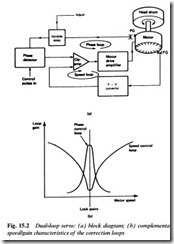SERVO SYSTEMS
A servo system, in the context of domestic electronic equipment, consists in its simplest terms of a movable or rotating load and an electrical drive circuit with two inputs – reference and feedback – and one output. The reference input commands the system, and the feedback input conveys the state or position of the load; the output signal drives the load to the required position or speed such that reference and feedback signals agree; this is called a closed-loop system. The load is now positioned in accordance with the command/ reference input, and correction ceases until either the command or feedback inputs change (e.g. motor slowed by additional friction or different speed/position required) when servo output will drive or steer the load to restore the status quo, or meet the new requirements.
Servomechanisms find many applications in consumer service: auto- iris and auto-focus in video cameras; steering and homing-in of satellite receiving dishes; turntable speed and tracking control in audio and video disc players; and the main concern of this chapter, the regulation of tape positioning and transport in a videocassette recorder. These are velocity types which control the speed and phase of a rotating shaft, as opposed to positioning servos which hold the controlled device in a position specified by the input-command signal, e.g. lens and antenna servos. The operation of the latter types is easy to understand when the principles of velocity servos are mastered.
VIDEORECORDER SERVOS
The basic function of the capstan servo is to maintain an even and correct speed of the tape through the video deck; that of the head- drum servo is to ensure that (a) during record the video tracks are laid down on tape according to the appropriate format specification; and (b) that during replay the video head scans are perfectly aligned with their appointed tracks. This latter function can be (and usually is) performed by the capstan servo, whereby the head-drum servo maintains correct video head speed while the capstan positions the tape such that the video tracks are correctly aligned under the head sweep-paths.
As Chapter 13 showed, it is fundamental to all analogue helical- scan formats that each head enters its scan of the tape just before the arrival of the field sync pulse in the video waveform. This ensures that head changeover takes place at the correct point at the extreme bottom of the picture, and that all the recorded field sync pulses lie in a line across the bottom edge of the videotape ribbon. During record, then, the timing of a tacho pulse (head-position indicator) is compared in a phase detector with that of a 25 Hz (40 ms period) pulse derived from incoming field syncs in a ÷2 stage – the arrange- ment is depicted in Fig. 15.1. Here the magnet on the flywheel induces one pulse per revolution in the tacho coil – the PG pulse. The servo system drives the motor to the point where reference and feedback pulses are ‘phased up’, and maintains correct phase thereafter. The exact timing relationship between head position and field sync pulses is determined by a pulse delay circuit, and is adjusted to set the head changeover on record to take place seven TV lines before field sync. In practice a little overlap is permitted, and the head actually hits the tape about ten lines before the field sync pulse is written onto the tape.
Phase and speed loops
Video servo systems need two servo loops for optimum control of the head-drum motor: a speed-control loop to rapidly establish the correct rotational rate when starting from rest or recovering from a disturbance; and a phase control loop with high gain and ‘tight’ control to set the correct lock point without hunting or instability. We have already seen how correct phase is established with reference to a tachogenerator on the head drum or in the motor. Speed monitoring depends on a frequency (tone)-generator (FG) built into the motor itself. It usually takes the form of a multi-pole magnetic disc passing over a printed coil, the output frequency of which is proportional to motor speed. This signal passes into a form of frequency-to-voltage converter whose output is also applied to the motor as an error drive, forming a dual-loop servo with separate speed and phase sections as outlined in Fig. 15.2(a). The speed loop quickly brings the drum up to correct speed, then the phase loop takes over
to hold the ‘dynamic position’ of the head drum rigidly in accordance with the phase of the reference input. When the speed is incorrect, operation of the phase control loop is not required because its error voltage output is disordered at this time. Similarly the influence of the speed-correction loop is superfluous during the presence of a phase error. The gains of the two feedback loops are arranged to vary according to the motor speed, then, as shown in Fig. 15.2(b):
this gives optimum correction performance. Fine adjustment of the delay in the head-drum phase loop in Fig. 15.2(a) sets the head switching point relative to the field sync pulse, and may be set up with a preset resistor, a numerical value set in factory or service shop and held in EEPROM memory, see Chapter 22; or a completely automatic system whose reference point is the off-air (record) or off- tape (playback) field sync pulse.

